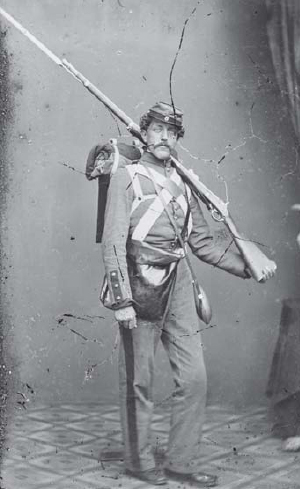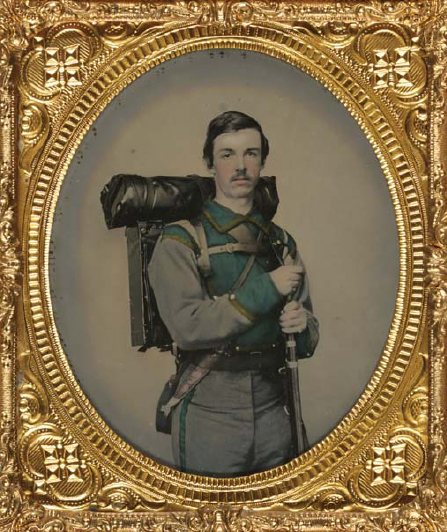
After the battle Jackson camped at Weyer’s Cave, just south of Port Republic, planning his next move. Frémont returned to Harrisonburg where he was directed to “Get your force well in hand and stand on the defensive,” and to “await further orders, which will be sent to you.” Shields marched slowly back to Front Royal and, on June 21, marched across the Blue Ridge to join Major-General Irvin McDowell. Banks remained in the vicinity of Winchester where he expected to send reinforcements to Frémont at the earliest opportunity. On June 12 he received a message from Frémont, stating that he had “beaten Jackson in two engagements and that Shields has been beaten on the opposite side of the river. Jackson has been re-enforced to the number of 30,000 or 35,000 men.”

The typical Union soldier carried a musket, percussion cap box, cartridge box, bayonet and scabbard, canteen and knapsack, in addition to his personnel effects. This image shows an unknown Union volunteer. (LOC)
Jackson would have loved to have been reinforced to resume the Valley offensive, but on the 17th he received orders to proceed to Richmond. His cavalry, now under Col. Thomas T. Munford, remained in the vicinity of Harrisonburg harassing Frémont till he withdrew first to Mount Jackson and eventually Middletown. Once Frémont pulled out of Harrisonburg, Munford also marched to Richmond, where the forces of Jackson and Ewell joined with the main part of the Army of Northern Virginia during the series of battles known as the Seven Days.
The Valley Campaign made Stonewall Jackson an international celebrity. In a classic military campaign he used surprise and maneuver to win five significant victories with a force of about 17,000 against a combined force of over 50,000. William Wood, in his 1921 volume, Captains of the Civil War, sums it up:
At McDowell, the Federals had 30,000 in strategic strength against 17,000 Confederates; yet the Confederates got 6000 on the field against no more than 2500. At Winchester, the Federal strategic strength was 60,000 against 16,000; yet the Confederate tactical strength was all of 16,000 against 7500 – one-eighth Banks’s total. At Cross Keys, the strategic strengths were 23,000 Federals against 13,000 Confederates; yet 12,750 Federals were beaten by 8000 Confederates. Finally, at Port Republic, the Federals, with a strategic strength of 22,000 against 12,700, could only bring a tactical strength of 4500 to bear on 6000 Confederates. The grand aggregate of these four remarkable actions is a Federal strategic strength of 135,000 against 58,700 Confederates. Yet in tactical strength the odds are reversed – 36,000 Confederates against 27,250 Federals. Stonewall Jackson, with strategic odds of nearly seven to three against him, managed to fight with tactical odds of four to three in his favor.

Confederate soldiers carried their possessions in a blanket roll worn across the shoulder and tied at the waist, along with a haversack, cartridge box, cap box, and musket. This image shows a Confederate soldier with an 1841 model Mississippi rifle. (LOC)
More importantly, he seriously disrupted McClellan’s offensive, causing Lincoln to intervene personally to ensure that the Federal capital was safe from the threat of attack. Indeed, before the battles of Cross Keys and Port Republic were even fought, Lincoln had reconsidered the value of tying up his forces in the Valley, and had again stepped in to reorganize the army. McDowell’s corps remained in the defense of Washington with only one division able to join McClellan on the Peninsula. After the campaign, the Army of Virginia was created under Maj. Gen. John Pope, incorporating the units of Banks, Frémont, and McDowell. Lee and Jackson soundly defeated this army in August at the second battle of Manassas/Bull Run, though without the participation of Frémont who refused to accept a position subordinate to Pope. He traveled to New York to await a subsequent assignment that never came.
Jackson’s performance during the Peninsula Campaign was not his best but, once Lee rose to command of the Army of Northern Virginia on June 1, the combined forces of Jackson and Longstreet conducted a series of brilliant campaigns culminating in Jackson’s most celebrated success at Chancellorsville in May 1863. It was also his last campaign. On May 3 while returning from a scouting party to locate the enemy’s forward lines, Stonewall was accidentally shot by his own men and died a week later. An attempt to save his life by amputating his arm failed to stop the infection that spread through his body, causing Lee to say, “he has lost his left arm, but I have lost my right arm.” Two months later, in a campaign that may have ended quite differently if Jackson had been there, Lee was soundly defeated at Gettysburg.